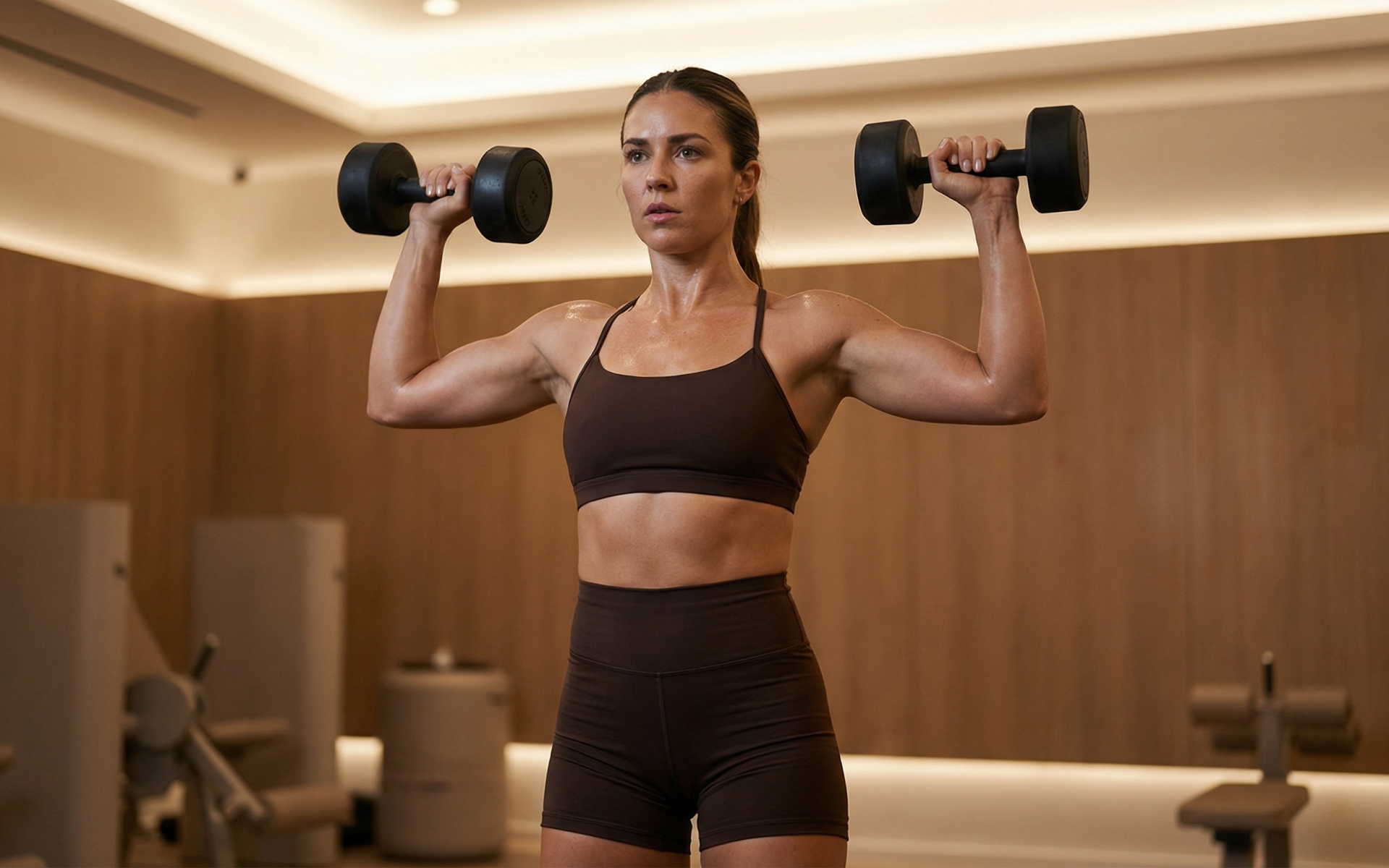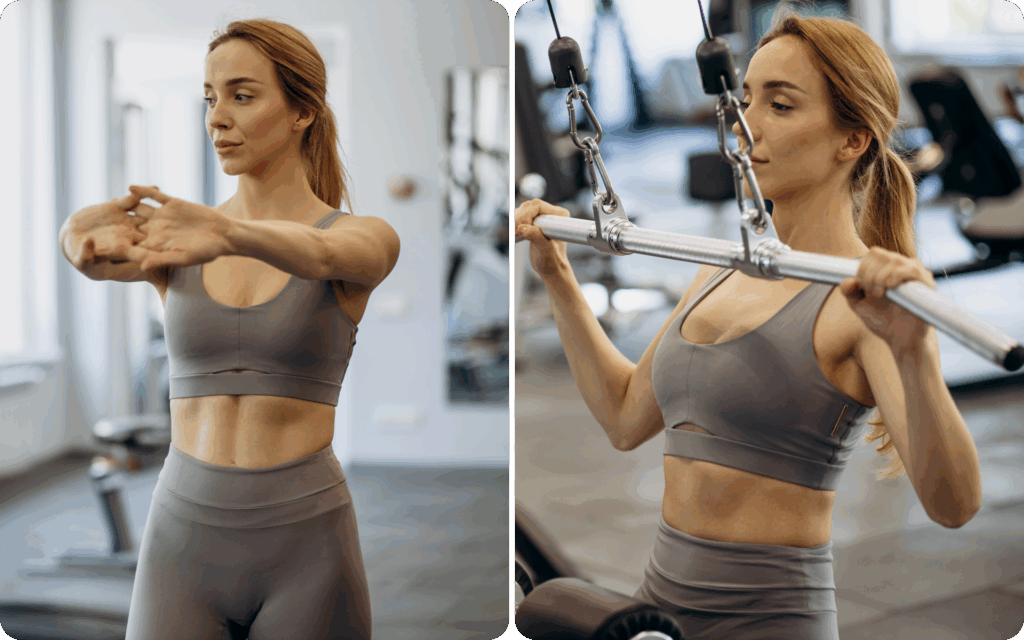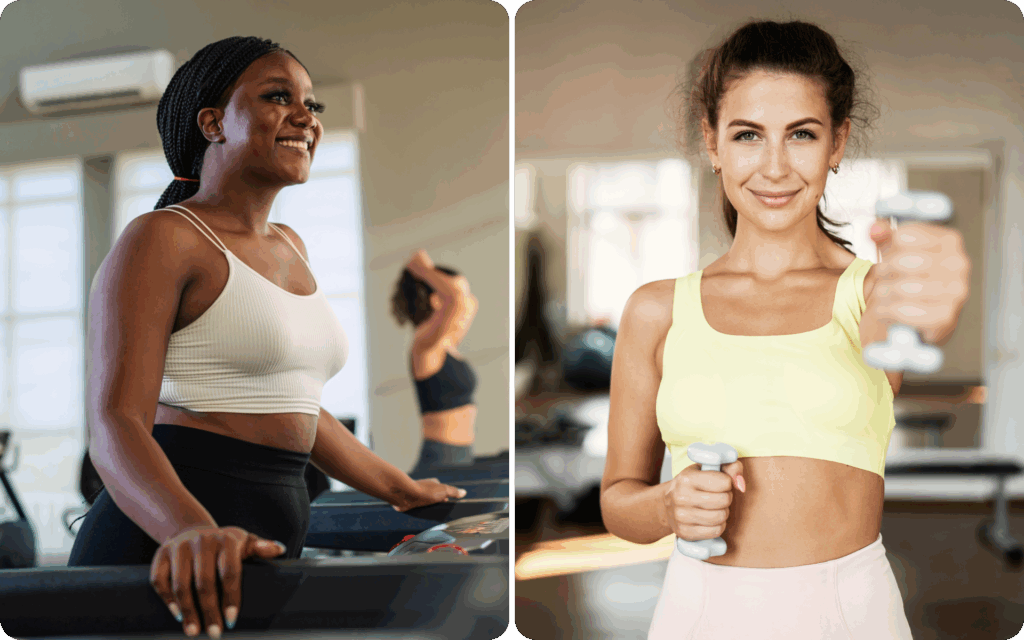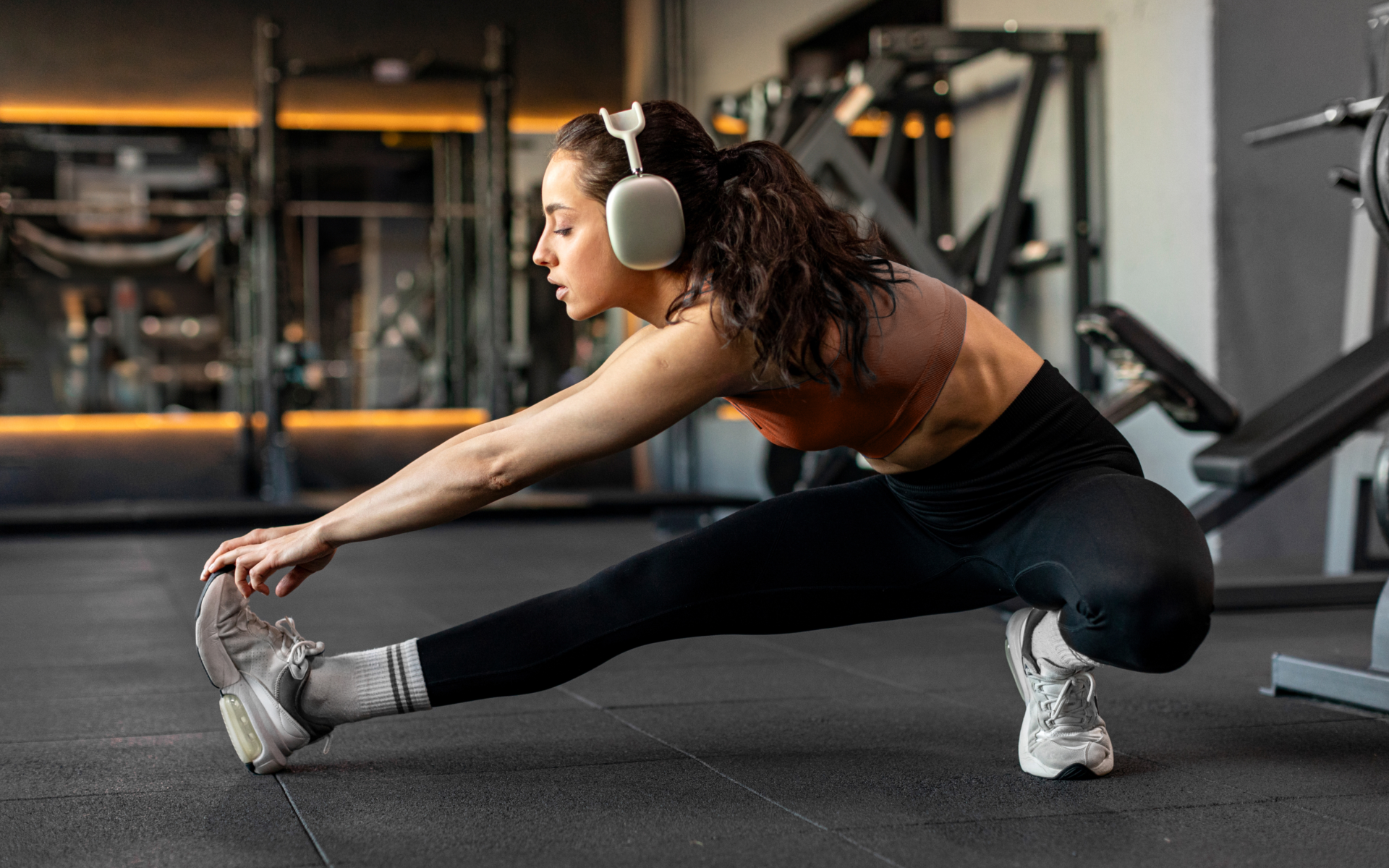Combining high-intensity interval training (HIIT) with strength training, a practice that is known as concurrent training, is a powerful way to build a well-rounded, athletic physique.
However, many people wonder if one type of training will cancel out the other. The key isn’t choosing one over the other, it’s understanding how to program them intelligently. This allows you to achieve your goals, whether that’s building muscle, shedding fat, or improving performance.
This guide breaks down the science behind concurrent training to give you a clear, actionable blueprint. We’ll explore how to structure your week, manage fatigue, and use specific programming variables to get the best of both worlds. You’ll learn not just what to do, but why it works, based on the latest research.
What Burns More Fat, HIIT or Weight Lifting?
HIIT is generally more effective for reducing body fat percentage, although both modalities contribute to a leaner physique (1).
A comprehensive 2025 meta-analysis published in Scientific Reports examined HIIT’s effects on recreationally active females. The researchers found that HIIT interventions produced a statistically significant reduction in body fat percentage, even though overall body mass did not change significantly. The time-efficient nature of HIIT also means that you can achieve significant metabolic benefits in shorter workouts (1).
On the other hand, weight lifting contributes through two mechanisms: calorie burn and increasing metabolic rate. The primary method of weight loss in the short term is through the caloric burn in your sessions. Depending on the weight of the person and intensity, this can range anywhere from 200 to 500 calories a session.
In addition, muscle is metabolically active and burns calories. This is essential for long-term fat management as it burns calories even at rest (2). However, this requires the accumulation to have a meaningful effect in making this a long-term adaptation.
So, how does this work at a cellular level?
- HIIT elevates your heart rate and creates a large energy deficit, which triggers a hormonal response that enhances fat oxidation (the process of breaking down fats for energy) (4).
- Weight lifting stimulates myofibrillar protein synthesis (MPS) – the fundamental process of repairing and building new muscle fibers (5) – which increases your resting metabolic rate over time (2).
For optimal results, a combined approach is best. Use HIIT to accelerate fat loss and improve cardiovascular health, and strength training to build the metabolic engine that keeps you lean (6).
Are you ready to kickstart your fat loss journey? Find effective routines in our guide to HIIT workouts for weight loss.
Read more: 30-Day Full-Body Workout Plan for Strength and Hypertrophy
How Do You Combine HIIT and Strength Training in a Week?
You can effectively combine HIIT and strength training by strategically managing their order, timing, and recovery. The primary concern with concurrent training is the “interference effect”, where the physiological signals from endurance exercise can blunt the adaptations from strength training (7).
A 2024 review in Medicine (Baltimore) provides a clear framework for minimizing this interference (8).
BetterMe: Health Coaching app helps you achieve your body goals with ease and efficiency by helping to choose proper meal plans and effective workouts. Start using our app and you will see good results in a short time.
The core issue lies in two competing cellular pathways:
- AMPK (AMP-activated protein kinase): This pathway is activated by endurance exercise and signals the body to improve energy efficiency and mitochondrial growth (8).
- mTORC1 (mechanistic target of rapamycin complex 1): This pathway is activated by mechanical tension from lifting heavy weights and is the master regulator of muscle protein synthesis and growth (8).
When you perform HIIT and strength training too close together, the AMPK signal from cardio can temporarily suppress the mTORC1 signal from lifting. This doesn’t mean you can’t get stronger, it just means that you need to be smart about your schedule.
Guiding Principles for Combining Workouts
- Separate Sessions by at Least 6 Hours: If you must train both on the same day, allow a minimum of 6 hours between sessions. This gives your body time for the molecular signaling from the first workout to peak and start to resolve before you introduce a competing stimulus. A 24-hour separation is even better for maximizing adaptations from both (8).
- Prioritize Your Main Goal: On days you train both, perform the workout that is aligned with your primary goal first. If your focus is building strength or muscle mass, lift weights first when you are fresh. This allows you to generate maximum force and mechanical tension. If your priority is cardiovascular fitness, do HIIT first.
- Choose Low-Impact HIIT Modalities: A 2024 review noted that HIIT on a stationary bike or rower causes less eccentric muscle damage and neuromuscular fatigue than running (8). This is particularly important for preserving performance in lower-body strength sessions. Running-induced delayed onset muscle soreness (DOMS) can compromise your squat or deadlift form for days (9).
- Manage Your Weekly Volume: The risk of interference increases with frequency. Aim for no more than two HIIT sessions per week when you’re also following a demanding strength program. Pushing to three or more HIIT sessions can start to impede strength gains unless you carefully manage your lifting volume and recovery.
- Alternate Muscle Groups: Depending on your ability and equipment availability, you can alternate muscle groups to minimize interference. For example, you can cycle on upper-body days and swim or row on lower-body days.
Do you want to try HIIT using just your bodyweight? Check out our routines for a calisthenics HIIT workout.
How Many Times a Week Should You Do HIIT and Strength Training?
For most individuals, 2 HIIT sessions and 2-3 strength training sessions per week will provide an optimal balance for improving both fitness and body composition. This structure allows for sufficient recovery between high-intensity days, which is essential for adaptation and injury prevention.
Here’s what research has suggested for different goals:
- For Muscle Hypertrophy
A 2022 umbrella review confirmed a dose-response relationship between training volume and muscle growth. Essentially, this means that more volume produced greater results, at least up to a higher threshold.
To maximize hypertrophy, the evidence points toward performing at least 10 weekly sets per muscle group. This is most effectively achieved with 2-3 dedicated strength sessions per week. Limiting HIIT to 1-2 sessions per week ensures it doesn’t compromise the recovery needed for muscle repair and growth (10).
- For Fat Loss and Conditioning
If your primary goal is fat loss, you can increase your HIIT frequency to 2-3 sessions per week. The 2025 meta-analysis found that HIIT is highly effective at reducing body fat percentage (1).
To preserve lean muscle mass during a fat loss phase – which is essential for maintaining your metabolism (2) – continue with at least 2 full-body strength sessions per week. This is an effective setup for an HIIT and strength training weekly schedule for weight loss.
- For General Fitness
A balanced approach of 2 HIIT sessions and 2 strength training sessions per week is a sustainable and highly effective model (8).
This allows you to target all major fitness attributes – cardiovascular endurance, muscular strength, power, and body composition – without excessive fatigue. This is also a great starting point for a 30-day HIIT and strength training weekly schedule.
Read more: Strength Building Workout Plan for Long-Term Gains
What Is a Powerful HIIT and Strength Training Weekly Schedule?
A powerful schedule is one that is tailored to your primary goal, manages fatigue, and allows for consistent progression. Below are two evidence-based templates: one that prioritizes strength and hypertrophy and one that prioritizes conditioning and fat loss.
Beginner On-Ramp (2 Weeks)
Before jumping into a full schedule, beginners should lay a foundation. An HIIT and strength training weekly schedule for beginners should focus on technique and consistency.
- Week 1: 2x full-body strength days (focus on form, 3 sets of 8-12 reps, 2-3 reps in reserve), 1x HIIT Day (bike, 4-5 intervals).
- Week 2: 2x full-body strength days (increase weight slightly, 3 sets of 8-10 reps, 2 RIR), 2x HIIT Days (bike or rower, 5-6 intervals).
Whether you’re a workout beast or just a beginner making your first foray into the world of fitness and dieting – BetterMe has a lot to offer to both newbies and experts! Install the app and experience the versatility first-hand!
Schedule 1: Strength and Hypertrophy Priority
This schedule is designed to maximize muscle growth and strength gains while still improving cardiovascular fitness. Notice how heavy lower-body training is protected from HIIT-induced fatigue. This structure is also ideal for an HIIT and strength training weekly schedule that female lifters can use to build strength.
- Monday: Lower-Body Strength (Heavy)
- Back squat: 3 sets of 4-6 reps @ 80-85% 1RM (1-2 RIR)
- Romanian deadlift: 3 sets of 6-8 reps (2-3 RIR)
- Walking lunge: 3 sets of 8-10 reps per leg (2 RIR)
- Leg press: 3 sets of 8-12 reps (1-2 RIR)
- Calf raise: 4 sets of 10-15 reps (1 RIR)
- Rest: 2-3 minutes between compound lifts.
- Tuesday: HIIT and Core
- HIIT workout (bike): 8 intervals of 60s hard effort / 90s easy recovery.
- Core: 3 rounds of plank (60s) and side planks (30s each).
- Wednesday: Upper-Body Strength (Volume)
- Bench press: 4 sets of 8-12 reps (1-2 RIR)
- Pull-ups or lat pulldowns: 4 sets of 8-12 reps (1-2 RIR)
- Dumbbell shoulder press: 3 sets of 10-15 reps (1 RIR)
- Bent-over row: 3 sets of 10-12 reps (2 RIR)
- Bicep curls and tricep pushdowns: 3 sets of 12-15 reps (0-1 RIR)
- Rest: 60-90 seconds between sets.
- Thursday: Active Recovery or Rest
- Light walk, stretching, or complete rest.
- Friday: Full-Body Strength (Power Focus)
- Deadlift: 3 sets of 3-5 reps @ 85% 1RM (2-3 RIR)
- Incline dumbbell press: 3 sets of 6-10 reps (2 RIR)
- Goblet squat: 3 sets of 8-12 reps (2 RIR)
- Single-arm dumbbell row: 3 sets of 8-10 reps per arm (2 RIR)
- Face pulls: 3 sets of 15-20 reps (1 RIR)
- Rest: 2-3 minutes for heavy lifts, 90 seconds for others.
- Saturday: Optional Light Cardio or HIIT
- Choose one: 20-30 min Zone 2 cardio (conversational pace) or 15-min mixed-modal HIIT.
- Sunday: Rest
Schedule 2: Conditioning and Fat Loss Priority
This schedule maximizes calorie expenditure and improves VO2max (a measure of your body’s maximum oxygen uptake) while preserving muscle mass.
- Monday: Full-Body Strength and Finisher
- Goblet squat: 3×10
- Push-ups: 3x as many reps as possible (AMRAP)
- Dumbbell row: 3×12 per arm
- Overhead press: 3×10
- Finisher: 5 mins AMRAP of kettlebell swings.
- Tuesday: Running HIIT
- HIIT workout (run): 10 intervals of 30s sprint / 60s jog or walk.
- Wednesday: Full-Body Strength
- The same as Monday, but aim to increase weight or reps.
- Thursday: Active Recovery or Rest
- Friday: Mixed-Modal HIIT
- HIIT workout (mixed): 5 rounds of 45s work / 15s rest: burpees, kettlebell swings, rower, box jumps.
- Saturday: Optional Zone 2 Cardio
- 30-45 minutes of light jogging, cycling, or swimming.
- Sunday: Rest
Are you looking for more routines that combine cardio and resistance? Explore our guide to HIIT workouts with weights.
Can I Do HIIT After Strength Training?
Yes, you can do HIIT after strength training. In fact, this is the recommended order for those who are prioritizing strength or hypertrophy if both must be done in the same session.
Performing strength training first ensures your muscles aren’t pre-fatigued, which allows you to lift with maximum intensity and proper form. This maximizes the mechanical tension that is placed on the muscles, which is the primary driver for strength and size adaptations (11).
A 2024 review in Medicine (Baltimore) highlighted that residual fatigue from a previous workout can impair the quality of the second one (8). If you perform HIIT first, your ability to recruit high-threshold motor units during your subsequent lifting session will be diminished, which will compromise the very stimulus that is needed for growth.
However, be prepared for your HIIT performance to be slightly lower than if you’d done it on a separate day. Your focus should be on maintaining good form and hitting the intended intensity, even if the total output is reduced.
You should lift weights first if your primary goal is to build muscle or strength. This ensures you can apply maximal effort to your lifts without pre-fatigue, which is essential for stimulating growth and preventing injury. Yes, strength training 3 times a week is highly effective for building muscle and strength, particularly when following a well-structured program that hits all major muscle groups and applies progressive overload. You can see improvements in cardiovascular fitness (VO2max) in as little as 2-4 weeks. Noticeable changes in body composition, such as reduced body fat percentage, typically take 6-8 weeks of consistent training and proper nutrition (12). A 20-minute HIIT workout 2-3 times per week is enough to produce significant improvements in cardiovascular health and support fat loss. Daily HIIT isn’t recommended, as it can lead to overtraining and increase the risk of injury due to its high intensity.Frequently Asked Questions
Should I lift weights or do HIIT first?
Is strength training 3 times a week enough?
How long does it take to see results from HIIT?
Is a 20-minute HIIT workout a day enough?
The Bottom Line
Successfully combining HIIT and strength training isn’t a matter of chance, but of deliberate and informed programming. By understanding the physiological principles of adaptation and recovery, you can design a weekly schedule that allows you to build strength, increase muscle mass, and improve your conditioning simultaneously.
The key is to prioritize your primary goal, manage fatigue through smart scheduling and recovery, and fuel your body appropriately. With the evidence-based templates and exercises in this guide, you have the tools to create a powerful, sustainable training plan that delivers comprehensive results.
DISCLAIMER:
This article is intended for general informational purposes only and does not serve to address individual circumstances. It is not a substitute for professional advice or help and should not be relied on for making any kind of decision-making. Any action taken as a direct or indirect result of the information in this article is entirely at your own risk and is your sole responsibility.
BetterMe, its content staff, and its medical advisors accept no responsibility for inaccuracies, errors, misstatements, inconsistencies, or omissions and specifically disclaim any liability, loss or risk, personal, professional or otherwise, which may be incurred as a consequence, directly or indirectly, of the use and/or application of any content.
You should always seek the advice of your physician or other qualified health provider with any questions you may have regarding a medical condition or your specific situation. Never disregard professional medical advice or delay seeking it because of BetterMe content. If you suspect or think you may have a medical emergency, call your doctor.
SOURCES:
- Effects of high-intensity interval training on physical fitness and body composition in recreationally active females: a systematic review and meta- analysis (2025, nature.com)
- Increasing muscle mass to improve metabolism (2013, pmc.ncbi.nlm.nih.gov)
- Resistance Training Variables for Optimization of Muscle Hypertrophy: An Umbrella Review (2022, frontiersin.org)
- Fat Loss Depends on Energy Deficit Only, Independently of the Method for Weight Loss (2007, karger.com)
- Resistance training‐induced changes in integrated myofibrillar protein synthesis are related to hypertrophy only after attenuation of muscle damage (2016, pmc.ncbi.nlm.nih.gov)
- The Effects of Combining Aerobic and Heavy Resistance Training on Body Composition, Muscle Hypertrophy, and Exercise Satisfaction in Physically Active Adults (2023, mdpi.com)
- The Effects of Concurrent Aerobic and Strength Training on Muscle Fiber Hypertrophy: A Systematic Review and Meta-Analysis (2022, link.springer.com)
- Optimizing concurrent training programs: A review on factors that enhance muscle strength (2024, journals.lww.com)
- The Influence of the Aerobic Training on Muscle Hypertrophy: Literature Review (2019, researchgate.net)
- A Systematic Review of The Effects of Different Resistance Training Volumes on Muscle Hypertrophy (2022, pmc.ncbi.nlm.nih.gov)
- Anabolic signals and muscle hypertrophy – Significance for strength training in sports medicine (2025, sciencedirect.com)
- Adaptations to Endurance and Strength Training (2018, pmc.ncbi.nlm.nih.gov)














